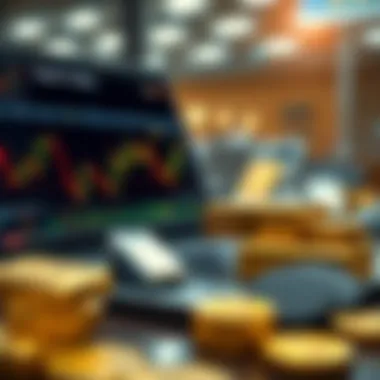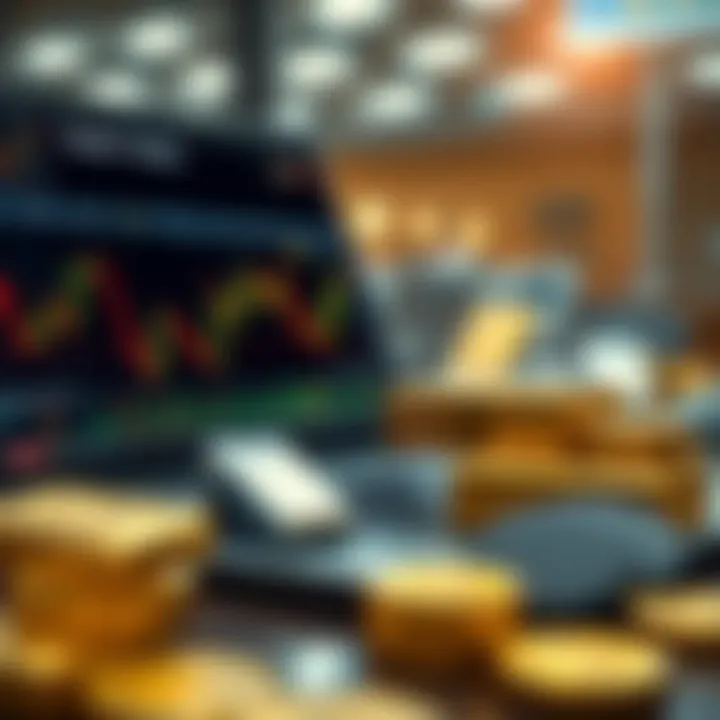Best Places to Buy Gold and Silver: A Guide


Intro
In the world of finance, the allure of gold and silver takes center stage for many investors looking to diversify their portfolios. These precious metals have stood the test of time, not only serving as a means of trade but also as a hedge against inflation and economic instability. Understanding where to buy gold and silver goes beyond just finding a store or a website; it entails navigating a market that's as unpredictable as a cat on a hot tin roof. With options ranging from traditional dealers to online platforms, each avenue comes with its own set of characteristics, advantages, and, at times, pitfalls.
Whether you’re a greenhorn or a seasoned aficionado, knowing the nitty-gritty is essential. This article explores various methods and avenues for purchasing gold and silver. We will focus on the reliability of dealers, prevailing market conditions, and how your investment goals shape your choices. From online suppliers to brick-and-mortar stores, we will scrutinize these options, enabling you to make sound decisions for your financial future.
Investment Terminology
Grappling with gold and silver buying isn't as simple as picking a shiny object off a shelf. You'll need to arm yourself with some essential knowledge. Here are the critical definitions you should be familiar with:
Key Definitions
- Bullion: This term refers to gold or silver in bulk form, valued primarily by weight. Think of it as raw material, often minted into bars or coins.
- Spot Price: The real-time price of gold or silver per ounce, influenced by market demand and supply.
- Premium: Over and above the spot price, this is what you pay for the physical metal, covering the costs of production, distribution, and profit for the seller.
Commonly Used Terms
- Assay: A test to determine the purity of the metal, ensuring you get what you pay for.
- Certificate of Authenticity: Documentation that proves the metal’s quality and source, giving buyers peace of mind.
- Liquidity: Your ability to quickly convert your gold and silver into cash without significant loss of value. High liquidity means you can sell easily.
Arming yourself with these terms puts you a step ahead. Knowing what you’re talking about not only helps in negotiations but also builds your confidence in making informed choices.
Expert Advice
Now that you’ve got the terminology under your belt, let’s get to the heart of the matter: strategies and tips.
Investment Strategies
- Buy Low, Sell High: This time-tested mantra applies here. Keep an eye on economic forecasts and assess when it’s beneficial to buy versus sell.
- Diversification: Don’t put all your eggs in one basket. Spread your investments across different forms of gold and silver, including coins, bars, or even ETFs.
- Long-Term Holding: Precious metals tend to appreciate over time. If you can afford to sit tight and wait out the market fluctuations, consider a long-term approach.
Risk Management Tips
- Research Dealers: Verify the credibility of your seller. Read reviews, check their track record, and ensure they are transparent about their pricing.
- Stay Informed: Follow industry news and data on the market trends. Websites like Investopedia and CoinMarketCap can provide valuable insights.
- Secure Storage: Gold and silver are tangible assets, meaning they need to be kept in a safe location. Consider options like bank safety deposit boxes or reputable storage facilities.
"Knowledge is the key to making wise investment choices; without it, you are simply gambling your future."
Whether you’re just dipping your toes or diving headfirst into gold and silver, this article aims to provide you the insights needed to make prudent choices in this fascinating market.
Understanding Gold and Silver Investments
Grasping the landscape of gold and silver investments is crucial, especially in today’s economic scenario where uncertainty seems to be a given. These precious metals have long been regarded not just as forms of currency but as vital assets in a diversified investment portfolio. Investing in gold and silver comes with their unique set of advantages and challenges that every potential buyer should understand before making any decisions.
The Role of Precious Metals in Investment
Precious metals serve as a hedge against inflation and economic downturns, providing a sense of security during tumultuous financial periods. Investors often flock to gold and silver particularly when the stock market shows volatility or when geopolitical tensions rise.
- Capital Preservation: Gold and silver maintain their intrinsic value well over time, unlike paper currencies that can be impacted by inflation.
- Portfolio Diversification: Introducing precious metals into an investment strategy can help mitigate risks associated with stocks and bonds.
- Psychological Assurance: The tangible nature of precious metals can offer comfort; unlike digital currencies, they can physically hold their value.
In summary, precious metals act as a stabilizing force in an investor's portfolio, ensuring safety and growth potential over the long haul.
Historical Performance of Gold and Silver
Reflecting on the historical performance of gold and silver offers valuable insights into their behavior as investments. Historically, both metals have demonstrated resilience during economic hardships, which is noteworthy. For example, during the 2008 financial crisis, gold prices soared, demonstrating a flight to safety. Silver, often considered the “poor man’s gold,” also saw significant gains, albeit with more volatility.
In examining past trends, consider:
- Great Depression: Gold's price climbed dramatically, reflecting its role as a safe haven.
- 2008 Financial Crisis: Renewed interest in gold and silver as markets crashed and investor confidence dwindled.
This historical context not only illustrates past performance but serves as a predictive tool for potential future behavior in various market conditions.
The Current Market Trends
As of now, the current market trends of gold and silver are something to keep an eye on. Factors such as global economic instability, changes in interest rates, and inflation impact their prices significantly. Recently, gold has shown a steady increase due to investors seeking secure assets amid rising inflation rates and geopolitical unrest.
Investors should also be aware of:
- Central Bank Policies: When central banks buy gold, it typically signals a bullish trend for prices.
- Technological Demand: For silver, increasing demand in electronics and renewable energy technologies could thrust prices upward.
- Market Sentiment: General investor sentiment around precious metals can sway the market considerably, as seen in times of uncertainty.
"The demand for gold and silver is invariably tied to the broader economic picture, and understanding these dynamics is essential for any investor."
Keeping abreast of these trends helps investors position themselves advantageously and make informed purchasing decisions in this intricate market.


By digging deeper into the motivations behind gold and silver investments, their historical significance, and current market dynamics, one can approach the buying process with a well-rounded understanding, effectively navigating the risks and rewards associated with these timeless assets.
For more detailed information on current market trends, consider checking financial news websites like Bloomberg or market analytics from Kitco.
Types of Gold and Silver Products
When considering an investment in precious metals like gold and silver, understanding the types of products available is pivotal. Each category serves different investment goals and offers unique benefits. Knowing these products can empower you to make informed choices and navigate the market with clarity.
Bullion Coins
Bullion coins are often seen as the gold standard for investing in precious metals. These coins are minted primarily for investment purposes and are typically made of gold or silver of high purity. The most famous examples include the American Gold Eagle and the Canadian Silver Maple Leaf. Their value is directly tied to the current market prices of the metals they contain.
The importance of bullion coins lies in their liquidity. They are widely recognized and accepted, making it easy to buy and sell. Additionally, they tend to carry a lower premium over the metal's value compared to collectible items. Investors appreciate their ease of storage and transport, and government backing adds an extra layer of security.
However, it's worth noting that the market for bullion coins can fluctuate. Before purchasing, it's wise to monitor market trends closely and consider whether these coins align with your broader investment strategy.
Bullion Bars
Bullion bars are another excellent option for those looking to invest in precious metals. These bars come in various weights, typically ranging from 1 ounce to 1 kilo, and are made from high-purity gold or silver. Unlike coins, bullion bars do not have any design or artistry that contributes to their value—only the metal content matters.
Investors often prefer bullion bars due to the lower premiums over spot prices relative to bullion coins. This means that, for the same amount of gold or silver, you may pay less when buying bars than you would for coins. However, bullion bars can be less liquid, especially larger ones, as not all dealers may be willing to buy them back.
Collectible Coins
For those who appreciate both the aesthetic and investment potential, collectible coins present a unique opportunity. Unlike bullion products, their value is derived from rarity, demand, and historical significance, alongside the intrinsic metal value. A classic example is the Saint-Gaudens Double Eagle, which holds appeal for both collectors and investors alike.
Collectible coins, however, come with their own set of complexities and risks. Prices can vary dramatically based on collector interest and market trends, which does not always align with the spot price of the metal. As such, investing in collectible coins may require a keen understanding of numismatics and trends within the collector community.
Silver Rounds
Silver rounds are often viewed as a middle ground between bullion coins and bars. These rounds are usually 1 ounce of pure silver and are produced by private mints. They often carry designs similar to collectible coins but, unlike coins, are not legal tender. Their value is based primarily on the .999 fine silver content.
Investors are drawn to silver rounds due to their affordability—many rounds have a lower premium over spot price compared to silver coins. However, potential buyers should be aware that while they offer great flexibility, they may have lower liquidity than recognized coinage, which can impact resale opportunities.
When considering which type of precious metal product to purchase, reflect on your individual investment goals and market conditions.
Where to Purchase Gold and Silver
When it comes down to investing in gold and silver, knowing where to purchase these precious metals is as crucial as the decision to buy them themselves. Each buying avenue presents unique advantages and challenges that can affect both your investment's security and your overall experience in the market. With countless options available—from local coin shops to online retailers—understanding the landscape is paramount.
Let's dive into the various purchasing channels to facilitate a well-informed investment journey.
Local Coin Shops
Local coin shops often operate under the radar, providing a personal touch that online transactions can't replicate. One of the perks of buying at these physical locations is the ability to physically inspect the products before making any commitment. When you walk into a shop, you can gauge authenticity, check for marks or scratches, and evaluate weights. Additionally, most shop owners are quite knowledgeable. A good chat can yield valuable insights, helping you learn the ropes about gold and silver investments.
However, expect to pay a premium. Often, these shops have higher overhead costs which are passed onto consumers. Be mindful of pricing and compare to larger markets.
Online Retailers
The online realm has exploded with options for purchasing precious metals; Web-based retailers offer convenience and often competitive prices. Names like APMEX and JM Bullion provide detailed product descriptions and user-friendly interfaces, appealing to seasoned investors and novices alike. The ease of comparing prices can be a real game-changer.
One downside? Shipping time. Though buying online is convenient, waiting for your investment to arrive can feel like a huge drawback. You also have to be wary about online scams. It’s essential to verify the legitimacy of the retailer you’re purchasing from.
Auction Sites
Auction sites like eBay provide a unique twist in the gold and silver purchasing game. This is where savvy investors sometimes strike gold—pun intended—by scoring deals on rare or collectible items that may not be easily found elsewhere. However, tread carefully; auction sites can be a double-edged sword.
Ensure you thoroughly understand the seller’s ratings, be cautious of hidden fees, and familiarize yourself with the bidding process before jumping in. Many successful investors have been drawn to the thrill of bidding wars, but remember: it requires a strategy and sometimes, a steady hand.
Financial Institutions
Some banks and credit unions offer precious metal purchasing services, presenting another layer of security for investors wary of less formal channels. Institutions like Wells Fargo and HSBC provide a trusted environment for obtaining gold and silver francs at regulated prices, which can further establish your peace of mind.
Keep in mind that the selection might not be vast, and the premiums can also be steeper than other venues. But, the stability of the banking system might just tip the scales in your favor when considering where to invest your hard-earned cash.
Direct from Mints
Purchasing directly from mints—such as the United States Mint or the Royal Canadian Mint—can seem daunting initially, yet it often proves worthwhile. Buying from the source can guarantee authenticity and quality while potentially providing lower premiums than retail shops.


However, keep an eye on minimum purchase quantities and the availability of popular products. Being on a waitlist sometimes can feel like patiently waiting for a bus that seems perpetually delayed. If you’re a serious investor, signing up for notifications might be a smart move to maximize opportunities.
Consider the advantages and disadvantages of each option carefully. Selecting the right purchasing avenue will not only enhance your investment experience but may also prove pivotal in shielding your finances in the turbulent waters of precious metal investment.
"In the intricate world of precious metals, being informed is key to making savvy decisions and avoiding common pitfalls."
In summation, whether you choose a cozy local shop, a website from the comfort of your couch, or something as adventurous as an auction site, make sure to prioritize security, authenticity, and your own comfort levels when investing in gold and silver.
Evaluating Dealers and Online Platforms
When venturing into the gold and silver market, the assessment of dealers and online platforms emerges as a pivotal aspect. The reliability of your chosen dealer can determine not only the authenticity of the products you receive but also the overall experience, including customer service and after-sale support. With the increasing presence of online platforms, it becomes essential to sift through numerous options to lead you to trustworthy outlets, ensuring your investments are in safe hands. Thus, analyzing dealers scrutinizes key parts: reputation, customer experiences, and commitment to transparent pricing.
Assessing Reputation
Reputation is the bedrock upon which the trust of any dealer stands. Look for dealers who have established a solid history, as this often leads to better practices. Ideally, they should have been in the business for several years, gaining knowledge of market intricacies along the way. Don’t shy away from doing a little digging. Visit forums such as Reddit or specialized precious metal communities. It’s always wise to check if the dealer is endorsed by organizations like the American Numismatic Association or the Professional Numismatists Guild. Such associations often hold members to strict ethical standards.
In terms of quantitative measures, consider examining the rating of dealers on Better Business Bureau, which can reveal complaints or regulatory actions that may have arisen concerning a dealer’s service.
Customer Reviews and Testimonials
Customer feedback serves as a reality check. The experiences of previous buyers can illuminate the strengths and weaknesses of a dealer or platform. Look for patterns in reviews. Are customers consistently pleased with their purchases, or are complaints about delays and product quality common? Seek detailed testimonials rather than superficial ratings. Review platforms – not just dealer websites – can provide insights that are more candid.
"The feedback from other customers can act like your wise neighbor. They’ve walked the path before you and know the bumps along the way."
A mixed bag of reviews isn’t inherently bad; it might just reflect varying expectations. If issues arise frequently, though, it’s a red flag. Platforms like Trustpilot can be a valuable resource for locating honest assessments of dealers.
Price Comparison and Transparency
When dealing with precious metals, being savvy about pricing is essential. It’s not just about getting the lowest price but understanding how prices correspond to market conditions. Dealers who provide a transparent pricing structure win extra points. Knowing the premium on top of the spot price of gold or silver helps you gauge whether you're getting a fair deal or if you're being led down the garden path.
Countercheck prices across several platforms before making a final decision. Utilize comparison tools or aggregators online, which can provide side-by-side detailing of prices from various dealers. Always verify if there are hidden costs such as shipping, handling, or storage fees, as these can chip away at your investment's overall worth.
In summary, investing time in evaluating dealers and online platforms can pave the way for a more informed and rewarding investment experience in the world of precious metals. Establishing that foundation of knowledge sets the stage for wiser choices down the line.
Factors to Consider Before Buying
When it comes to purchasing gold and silver, making informed decisions is paramount. The precious metal markets are known for their volatility, influenced by various elements that can sway prices in the blink of an eye. Thus, before diving into the waters of investment, there are a few critical factors to mull over. These considerations can greatly enhance the chances of making wise financial choices.
Market Conditions
Understanding the market conditions is like reading the weather before a big trip; it can save you from stormy days. Prices of gold and silver can fluctuate due to a myriad of reasons, such as economic indicators, geopolitical tensions, or shifts in currency strength.
- To gauge whether it’s a good time to buy, pay attention to:
- Interest rates
- Inflation rates
- Central bank policies
Monitoring these factors can offer valuable insight into when it might be the right moment to make a purchase. If the winds are blowing in your favor, it could be an opportune time. However, waiting for the rear-view mirror to provide clues can often lead to missed opportunities. Therefore, staying informed through reliable sources can help you navigate this intricate market.
Storage and Insurance
Once you’ve acquired your shiny new assets, the next question is, where do you keep them? Storage is a vital cog in the wheel of precious metal investment. It’s not just about buying; it’s also about safeguarding your purchase. Storing gold and silver safely can vary based on personal preferences and financial strategy.
- Here are some common storage options:
- Safe deposit boxes at banks
- Home safes
- Professional vaults
Each storage method comes with its own advantages and downsides. For example, having them at home might seem convenient, but it can introduce risks of theft or damage. On the other hand, professional storage solutions provide security but usually come with hefty fees.
Don’t forget about insurance either. Insuring your precious metals ensures protection against unforeseen circumstances. It’s a smart move that can save you from substantial losses should something unfortunate happen.
Liquidity of the Investment
Lastly, there’s liquidity. This term refers to how quickly and easily an investment can be converted into cash without significantly impacting its price. With gold and silver, liquidity can fluctuate based on market demand, the form in which you own the metals, and current economic conditions.
Generally:
- Bullion coins and bars tend to have good liquidity due to broad acceptance and recognizable value.
- Collectible coins, while potentially more valuable, may take longer to sell as they depend heavily on collector demand.
Knowing the liquidity of your investments is essential because, in times of need, you may want to access cash quickly. A well-thought-out strategy regarding liquidity ensures that you can maneuver your portfolio effectively, allowing for flexibility in your financial planning.


Legal Considerations in Purchasing Precious Metals
When diving into the realm of gold and silver investments, one can't ignore the importance of understanding the legal considerations. These aspects are not just regulatory hurdles; they play a pivotal role in safeguarding your investment and keeping you on the right side of the law. Navigating this landscape is essential for any investor, whether you are a beginner or a seasoned one.
Understanding the legal framework around precious metals can help investors avoid pitfalls. From tax implications to proper documentation, knowing what to look out for can make your buying experience smoother. Regulations may vary significantly depending on your location, making it all the more essential to be informed.
Taxes Related to Gold and Silver Purchases
When investing in gold and silver, tax obligations are a key consideration to keep in mind. In many jurisdictions, the purchase and sale of precious metals can trigger capital gains taxes. For instance, if you buy an ounce of gold today for $1,800 and sell it later for $2,000, the profit you make is subject to taxation. The specifics of how these taxes are applied can often depend on your local laws.
Some notable points on taxes related to precious metals include:
- Sales Tax: Many states in the U.S. assess sales tax on bullion and numismatic coins. However, some jurisdictions, like Texas, do not charge taxes on bullion purchases.
- Capital Gains Tax: This is typically applied when you sell your investment. The rate can vary based on how long you've held the asset — short-term vs. long-term gains can have different tax implications.
- Tax Reporting: In most cases, all transactions must be reported, especially if they exceed a certain threshold.
Given these factors, it might be wise to engage a tax advisor familiar with precious metals to navigate these complexities.
Documentation and Receipts
When purchasing gold or silver, it's crucial to maintain proper documentation. This goes beyond just collecting receipts; it's about having a comprehensive and organized record of your transactions. Good documentation can be vital for both tax purposes and any future sales of your investment.
Here are some points to consider regarding documentation:
- Keep All Receipts: Retaining receipts of purchases can serve as proof of ownership and price paid. They also come in handy if you're ever audited.
- Certificates of Authenticity: When buying collectible coins or bars, ensure they come with a certificate that confirms their authenticity. This can greatly enhance resale value in the market.
- Transaction Records: Document who you bought from, when you made the purchase, and under what terms. This information can be valuable both for your records and if you decide to sell later.
"Documenting every step of your investment journey is not just good practice; it can save you from headaches down the road."
In essence, being proactive with your documentation ensures that your investment is backed by a solid paper trail. Ultimately, understanding these legal considerations is not just about compliance; it’s about empowering yourself to make informed and confident decisions in your investment journey.
Alternative Investment Methods
When discussing where to buy gold and silver, it's not just about physical assets. Alternative investment methods have become a viable option for those looking to diversify their portfolios without the hassle of storage and liquidity issues. These methods allow investors to gain exposure to precious metals while also providing flexibility and, in some cases, enhanced accessibility.
Gold and Silver ETFs
Exchange-Traded Funds (ETFs) focused on gold and silver represent a compelling way to invest in precious metals without having to physically handle them. Think of them as a way to own these metals indirectly, like having a slice of a giant pie instead of the whole thing.
- Diversification: Investing in ETFs can help reduce risk as they typically hold a basket of different assets. This means if one slumps, there are others that may balance out your investment.
- Liquidity: Unlike physical gold and silver, ETFs can be bought or sold on the stock exchange throughout the trading day, offering investors a liquidity that is often hard to find with physical holdings.
- Cost-Effective: Fees associated with ETFs are generally lower than the costs linked with purchasing physical bullion, such as shipping and storage fees.
However, it's crucial to check the composition of the ETF; some may invest in mining stocks rather than holding physical metals, which can affect how closely they reflect the actual price of gold and silver. It's a wise move to research the fund's performance and ticker symbol before jumping on the bandwagon. For an in-depth dive into ETFs, you might find Investopedia useful.
Mining Stocks
Investing in mining stocks is another alternative that comes with its own set of pros and cons. Rather than directly purchasing metal, you’re investing in companies that hunt for, extract, and sell gold and silver. Here are a few points to consider:
- Potential for Higher Returns: Mining stocks can offer bigger upside potential compared to an investment in commodities alone. When gold prices rise, mining companies tend to benefit significantly, which can lead to higher returns for shareholders.
- Inherent Risk: These investments are not without their pitfalls. The profitability of mining stocks can be influenced by a range of factors, including mining regulations, environmental concerns, and the operational efficiency of the company. If a mine has poor output or costly operational issues, stock prices can plummet swiftly.
Investors should also pay attention to the company’s management team, financial health, and operational efficiency. Websites like Yahoo Finance can aid in tracking stock performances and providing insightful analyses.
Adopting alternative investment methods like ETFs and mining stocks can offer a more nuanced approach to investing in gold and silver. Each method has its unique advantages that may cater differently depending on the investor’s goals and risk appetite. Whether you're looking for liquidity, diversification, or greater potential returns, exploring these avenues can enrich your investment portfolio.
Closure: Making Informed Choices
Navigating the world of gold and silver investments can feel a bit like walking a tightrope. There are various factors at play, and making a poorly informed decision can lead to quite the mess. Here, it's crucial to grasp that this conclusion isn’t just a wrap-up, but a stepping stone toward future decision-making.
Understanding where you should buy gold and silver plays a pivotal role in this financial landscape. Investors must assess their personal goals and risk tolerance, as they can significantly affect which avenue of procurement—be it local shops, online retailers, or direct purchases from mints—will suit one’s needs best. Education is your best ally. The more you know, the better equipped you'll be to steer clear of pitfalls and keep your investments shining bright.
Summarizing Key Points
As we summarize, let's hit on critical touchpoints:
- Diverse Options: There are plenty of buying options available, ranging from local coin shops to online platforms and even direct from mints. Each has its pros and cons, so knowing what you want is half the battle.
- Evaluating Dealers: Always check for dealer reputation and customer reviews. The trustworthiness of a dealer often correlates with your satisfaction and security in the purchase!
- Market Conditions Matter: Keeping an eye on market trends will serve you well. Prices for bullion can swing like a pendulum, making timing crucial.
- Legal Compliance: It’s essential to understand the tax implications that can catch unwary investors off-guard, as well as the importance of retaining proper documentation after each purchase.
- Investing Alternatives: Don't forget that ETFs and mining stocks offer alternative routes to exposure for gold and silver without the need to physically own the metals themselves.
"Knowledge is the bridge between desire and success" - a simple reminder that being well-informed can help you envision the way forward in your investment journey.
Future Outlook on Gold and Silver Investments
Looking ahead, the future of gold and silver investments is expected to be dynamic. Several factors are likely to influence the market. Geopolitical volatility, inflation rates, and shifts in monetary policy are just a few of the variables that can shake things up. For instance, if inflation continues to rise, many investors may flock to gold as a safe haven, bolstering demand and potentially driving prices higher.
Another factor to consider is technological advancements in mining and trading. Innovations could lead to more efficient processes, possibly lowering costs and affecting market prices in ways we can only speculate at this point. Sustainable mining practices are also gaining traction, as the world turns its focus towards responsible sourcing and environmental impact.
The overarching trend right now points to a burgeoning interest in digital assets tied to gold and silver, like blockchain-based gold. This could create new opportunities for savvy investors looking to diversify their portfolios further.
In summary, staying informed and adaptable is vital. With careful research, you can better navigate the twists and turns of the gold and silver market and make choices that not only align with your financial goals but also provide peace of mind.
Explore additional resources to deepen your understanding: Investopedia, The Balance, and Kitco.















